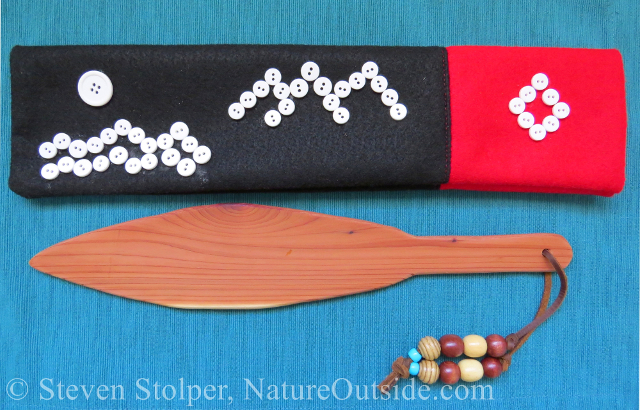
Life is about new experiences. That’s why I was eager to participate in a Native American cultural weekend put on by my friend Jim Lowery at Earthskills. Jim has has run this program for years, but this is the first time my schedule allows me to attend.
This year’s program centers around the crafts and stories of the Pacific Northwest. The patriarch of the weekend is a master storyteller and dancer with Tsimshian heritage. But a last-minute emergency keeps him from presiding over this year’s event. And it falls to his family and friends to orchestrate the gathering. Everyone pitches in and we have a wonderful time.
This Post contains affiliate links.
The Magic of the Pacific Northwest
I became interested in the First Nations of the Pacific Northwest almost twenty years ago. I traveled on two different sea kayak trips to observe Orca in the Johnstone Strait. The Johnstone Strait is a 68-mile channel along the northeast coast of Vancouver Island in British Columbia, Canada. During these voyages, I had the privilege to learn from the Kwakwaka’wakw who inhabit this region.
Later trips to the Pacific Northwest increased my admiration for the First Nations. If you are interested in reading about the ingenuity of the people, I recommend Hilary Stewart’s fascinating book, Cedar: Tree of Life to the Northwest Coast Indians.
Making a Ceremonial Canoe Paddle
We spend our weekend in the San Gabriel Mountains, dancing and telling stories.
One of the dances utilizes ceremonial canoe paddles. We make them ourselves out of cedar the day before the dance.
Each of us receives a 15” cedar plank that is roughed-out into a canoe paddle shape. I would prefer to rough-out the shape myself. But there were people of all skill levels at the gathering. And this made sure everyone can participate without spending too much time making their paddle.
The planks themselves are cedar grilling planks. But fence pickets from a big box store will also work. I suspect the grilling planks are higher quality wood and make more attractive paddles.
The first step is to file the edges of the paddle to make a gentle taper.
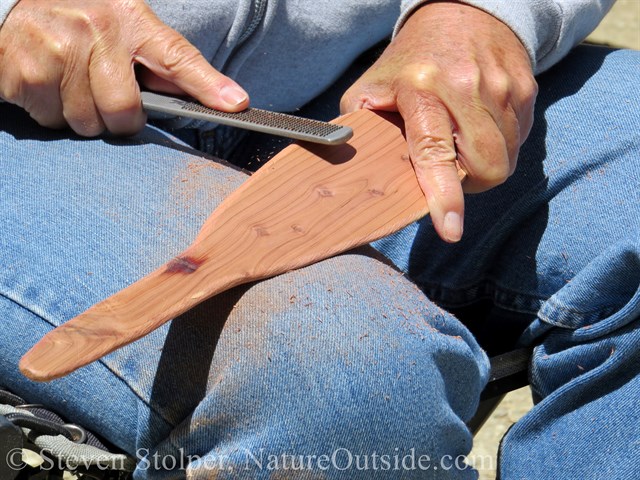
Using the file is much like sharpening a knife on a bench stone. I like to start near the base of the file and “pull” it toward me as I slide the file along the edge of the wood.
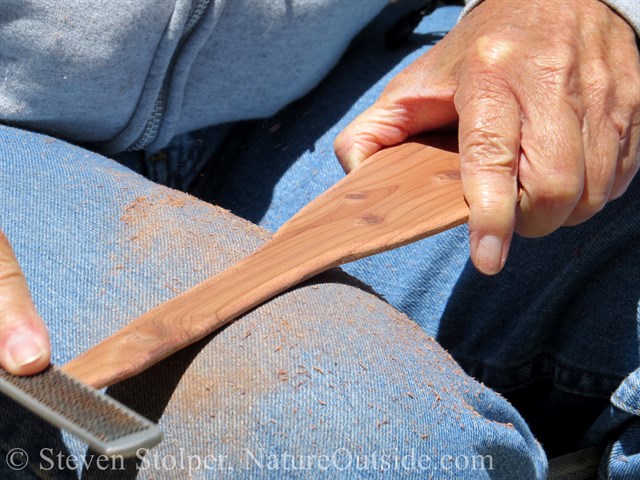
All the edges should be filed evenly.
Once we taper the edges, the next step is to sand the faces of the paddle. Sanding improves the feel of the paddle and accentuates the grain of the wood. Some planks have both the red heartwood and the white sapwood. To me, this gives the most visual interest to the finished paddle.
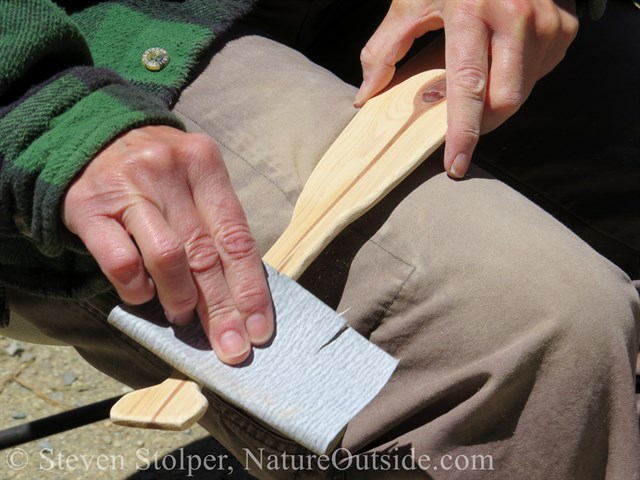
Sanding the paddle with increasingly finer sand paper
Style is what you make of it
You may notice that some paddles have a handgrip at the end while others are round. This is a matter of personal choice. I prefer the rounded end and remove the handgrip of my paddle. I use a Mora 120 carving knife to do it.
As an experiment, I try a crooked knife to even-out the shape of the paddle. But the cedar plank is too thin. I create small cracks I need to sand out later.
Here’s an example of a finished paddle. It’s made mostly from the lighter sapwood. The red heartwood contains oils that protect the wood against the elements. The sapwood is not resistant and is often cut away from wood that is exposed to the outdoors. But for a ceremonial paddle it is just fine (as is the large knot).
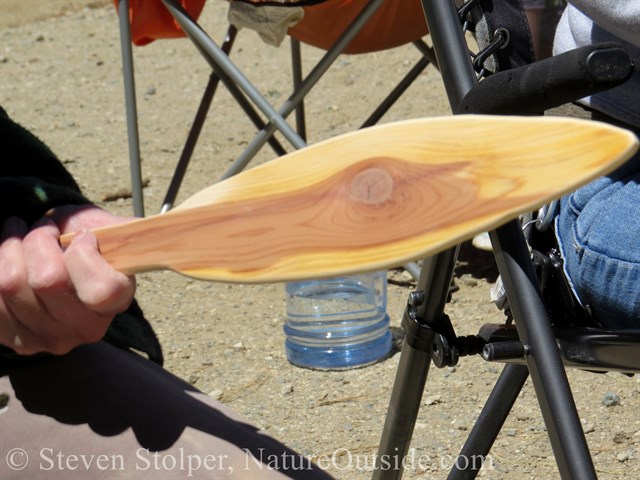
A finished paddle
Here is my finished paddle:
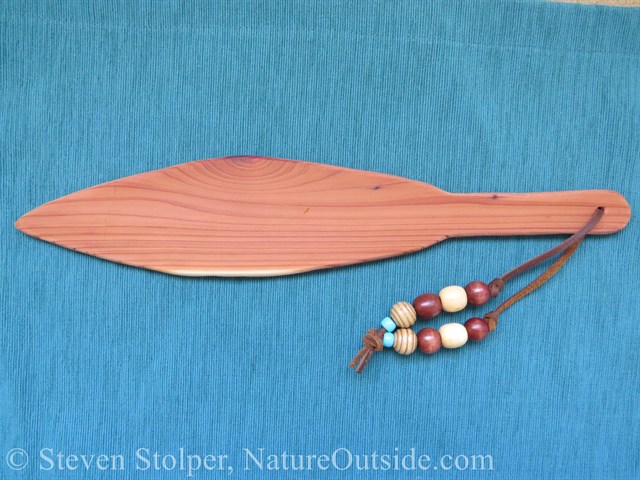
My paddle. I decorated the lanyard with beads.
I decorate my paddle with beads you can find at any crafts store. A big tub of beads will cost around seven dollars.
Pants for the Paddle
After creating our paddles, we want to protect them with a decorative covering. Our paddle covers are two pieces of different colored felt sewn together. Then the pieces are sewn closed inside-out. When the cover is flipped right-side-out, all the seams are hidden.
We decorate our paddle coveres by gluing buttons to them. We are given several traditional patterns to use. For example, I use “water” and “mountains.”
We can give free-reign to our creativity. But there is a constraint: It is bad form to use a Native American design you are not “given.” This makes sense. The designs represent the identity of the people who created them. It is not so much ownership of the pattern as it is the identity of the people the pattern represents. Here is my finished paddle cover:
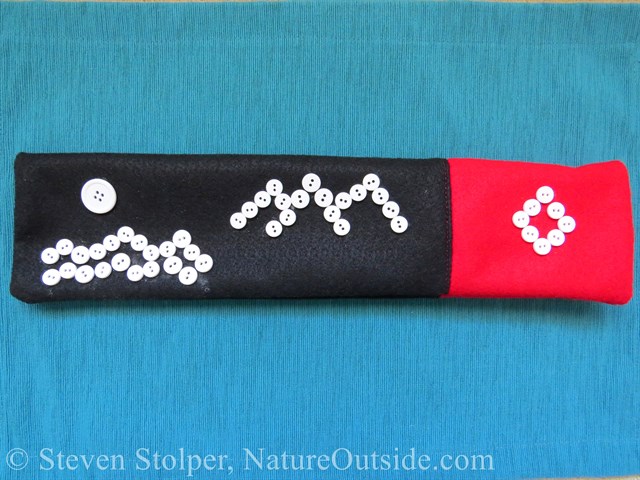
My finished paddle cover. I decorated it using buttons of different sizes. The motif is the moon over water and mountains.
Everybody Dance Now!
We spend much of the weekend dancing and telling stories. And my ceremonial canoe paddle will be a reminder of that wonderful weekend for many years to come.
Related Articles on NatureOutside
How to Make a Deerskin Pouch – 5 Easy Steps!
Use Your Knife – Make a Whimmy Diddle Bushcraft Toy (Video)
For fun facts and useful tips, join the free Bushcraft Newsletter.



Leave a Comment